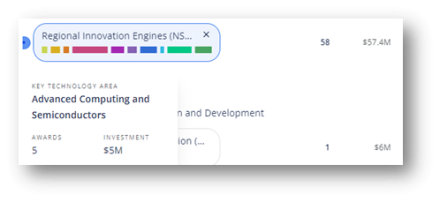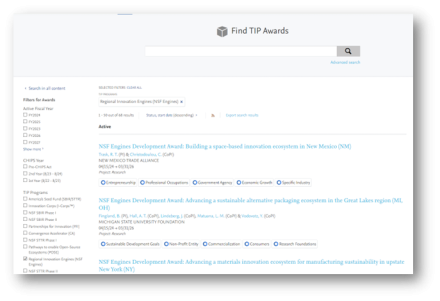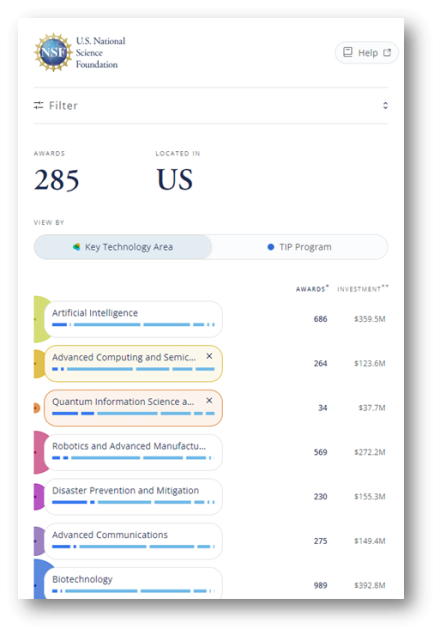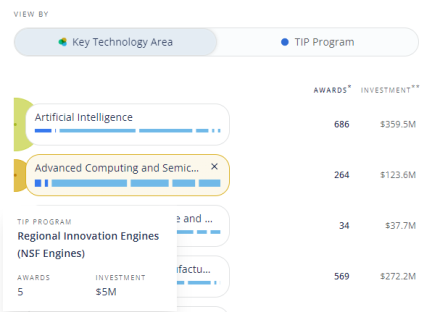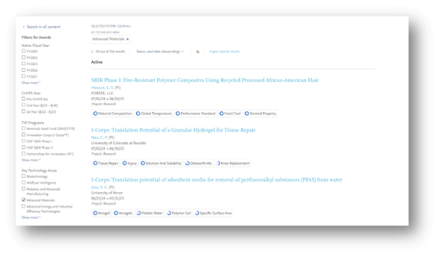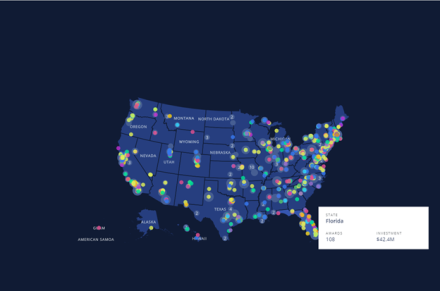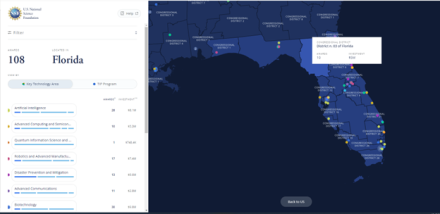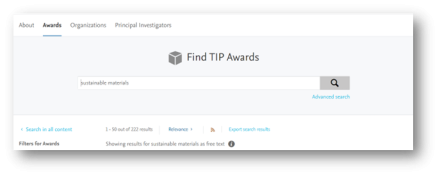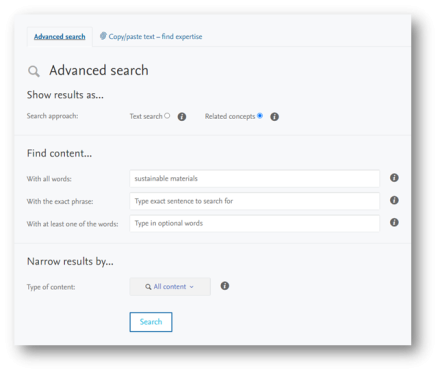TIP Investments pilot user guide
The U.S. National Science Foundation Directorate for Technology, Innovation and Partnerships (NSF TIP) launched the TIP Investments pilot, featuring a map and award data, to showcase the scale and impact of TIP's investments key technology areas across the nation. The TIP Investments pilot uses Elsevier's Pure platform, a research information management system that leverages open access data repositories to show the organizations, including startups and small businesses, as well as the principal investigators who are advancing the TIP portfolio. The tool illustrates the impact of NSF's investments across 10 key technology areas. Data in the visualization is pulled from the public NSF award search and categorized into key technology areas with machine learning.
Through the TIP Investments pilot, NSF invites users to access a comprehensive one-stop hub, showcasing the outcomes and impacts generated by TIP’s investments over time and evolving into a dynamic platform that fosters partnerships and helps create technologies, solutions, products and services rooted in the latest scientific and technological breakthroughs. Over time, NSF TIP will add more features and data to the platform.
What is included
- The TIP Investments pilot includes both awards and research contracts that are managed by TIP since August 2022. It does not include other NSF awards or supplemental funding from TIP to other NSF directorates or programs.
- It includes R&D awards and contracts active starting in Fiscal Year 2022 to present. Users may not see all NSF Convergence Accelerator track awards since many of those awards were completed prior to this timeframe.
- Data on awards are from NSF’s public award search and are updated daily, with a two-day delay from the award publication date.
- Researcher profile information is provided by Elsevier and new profiles are updated weekly.
Share your feedback with TIP
TIP Investments Pilot
Quick Start Guide
Awards by Key Technology Area
Awards by Programs
- The TIP Investments map allows users to filter awards by Active Fiscal Year, EPSCoR status, and Current Active Status.
- Each point on the map represents one organization receiving award(s)/contract(s).
- Clusters with numbers represent the number of awards/grants at an organization.
- Please note that awards and contracts may be tagged with multiple key technology areas and the number displayed includes duplicates.
- The investment/funding amount is “Total Intended Award Amount.”
- The dollar amount should not be used to calculate the budget. Some awards are continuing grants and it may appear as though NSF is investing more or less in a given year. Please contact tip@nsf.gov for more information about the budget.
- Switching between viewing the map by Key Technology Area to TIP Program, or vice versa, requires that any filters that were applied before changing the view must be re-applied.
Searching by TIP Program can be done on the map or in the database.
- On the Map: To search for one or more TIP Programs on the map, select TIP Program in the “View By” selector on the left sidebar, then select one or more TIP Program labels below.
- To further refine results by Key Technology Area within a TIP Program, select a TIP Program label in the left sidebar, then hover over or click on the colored horizontal bars within the label.
- To further refine results by Key Technology Area within a TIP Program, select a TIP Program label in the left sidebar, then hover over or click on the colored horizontal bars within the label.
- In the database portal: navigate to the Awards page, then select one or more TIP Programs from the TIP Programs filter.
Searching by KTA can be done on the map or in the database portal.
- On the Map: Select Key Technology Area in the “View By” selector on the left sidebar, and then select one or more KTA labels.
- To further refine results by TIP Program within a KTA, select a KTA label in the left sidebar, then hover over or click on the blue horizontal lines within the label.
- To further refine results by TIP Program within a KTA, select a KTA label in the left sidebar, then hover over or click on the blue horizontal lines within the label.
- In the database Portal: Navigate to the Awards page, then select one or more KTAs from the Key Technology Areas filter.
Searching for awards by state or congressional district is best achieved through the map.
- To view awards by state on the map, click on a state.
- To further refine results by congressional district, click on a state, then click on a congressional district.
- To return to the default map view, select the “Back to US” button at the bottom of the map view.
Searching by concept or keyword must be done in the Pure Portal.
Free text search
Concept Search
Select “Advanced Search” below the search bar on the Awards page, then select “Related concepts” for the Search approach. Enter keywords in one of the Find Content search bars, then click Search.
10 Key Technology Areas (KTA) are crucial for the nation’s economic and national security. TIP utilizes state-of-the-art machine learning to label awards with the corresponding KTA, ensuring a clear association between TIP awards and respective KTA. TIP has further broken down the KTA into 47 “Technology Foci” to better sort and filter awards.
KTA1 - Artificial intelligence, machine learning, autonomy, and related advances
- KTA1.1 Artificial Intelligence (excluding ML)
- KTA1.2 Machine Learning (ML)
- KTA1.3 Machine Learning Training Data
- KTA1.4 Autonomy
KTA2 - High-performance computing; semiconductors, and advanced computer hardware and
software
- KTA2.1 High-Performance Computing (HPC)
- KTA2.2 Advanced Computer Hardware
- KTA2.3 Advanced Computer Software
- KTA2.4 Semiconductors
KTA3 - Quantum information science and technology •
- KTA3.1 Quantum Computing Algorithms & Software
- KTA3.2 Quantum Computing Hardware
- KTA3.3 Quantum Communications and Networking
- KTA3.4 Quantum Sensing
- KTA3.5 Quantum Device Components and Manufacturing Methods
KTA4 - Robotics, automation, and advanced manufacturing
- KTA4.1 Robotics
- KTA4.2 Automation
- KTA4.3 Advanced Manufacturing (excluding biomanufacturing and semiconductor
manufacturing)
KTA5 - Natural and anthropogenic disaster prevention or mitigation •
- KTA5.1 Natural Disaster Prevention and Mitigation (excluding climate change adaptation &
mitigation) - KTA5.2 Climate Change Adaptation and Mitigation
- KTA5.3 Anthropogenic Disaster Prevention and Mitigation (excluding pandemics)
- KTA5.4 Pandemic Prevention and Response
KTA6 - Advanced communications technology and immersive technology
- KTA6.1 Wireless Communication — terrestrial and space
- KTA6.2 Wired and Fiber Communication
- KTA6.3 Spectrum Management
- KTA6.4 Communications and Network Security
- KTA6.5 Internetworking
- KTA6.6 Immersive Technology and edge devices
KTA7 - Biotechnology, medical technology, genomics, and synthetic biology
- KTA7.1 Biotechnology - Other than SynBio
- KTA7.2 Medical Technology
- KTA7.3 Genomics and Bioinformatics
- KTA7.4 Synthetic Biology
- KTA7.5 Biomanufacturing
KTA8 - Data storage, data management, distributed ledger technologies, and cybersecurity,
including bio-metrics
- KTA8.1 Data Storage
- KTA8.2 Data Management and Databases
- KTA8.3 Data Privacy
- KTA8.4 Distributed Ledger Technologies
- KTA8.5 Cybersecurity
- KTA8.6 Bio-metrics
KTA9 - Advanced energy and industrial efficiency technologies, such as batteries and advanced
nuclear technologies, including but not limited to for the purposes of electric generation
(consistent with section 15 of the National Science Foundation Act of 1950 (42 U.S.C. 1874) •
- KTA9.1 Advanced Batteries and Energy Storage Technologies
- KTA9.2 Advanced Energy Generation Technologies
- KTA9.3 Advanced Transmission and Distribution Systems
- KTA9.4 Carbon Management Technologies
- KTA9.5 Advanced Nuclear Technologies
- KTA9.6 Industrial Efficiency Technologies
KTA10 - Advanced materials science, including composites 2D materials, other next-generation
materials, and related manufacturing technologies
- KTA10.1 Composites (excluding 2D materials)
- KTA10.2 2D materials
- KTA10.3 Other next-generation materials
- KTA10.4 Related manufacturing technologies
A distinguishing feature of the Pure platform is the Elsevier Fingerprint Engine, which mines the text of public scientific documents, such as publication abstracts, funding announcements, patents, and awards, to create an index of weighted terms that defines the text fingerprint visualization.
Indexing
By compiling and comparing Fingerprint indexes, the engine enables institutions to look beyond metadata and find valuable connections among people, publications, funding opportunities and ideas. The engine powers many Elsevier solutions, including Pure and Expert Lookup, an Elsevier tool for finding reviewers, to inform decision-making.
Thesauri
Using a wide collection of thesauri, the engine can support applications pertaining to multiple subject areas. This allows Elsevier to develop solutions for researchers in the life sciences, engineering, Earth and environmental sciences, arts and humanities, social sciences, mathematics, agriculture and more.
How it Works
The Elsevier Fingerprint Engine creates indexes in the following steps:
- The Engine applies a variety of natural language processing techniques to mine the text of scientific documents, including publication abstracts, funding announcements, awards, project summaries, patents, proposals, applications and other sources.
- The Engine identifies key concepts that define the text using thesauri spanning major disciplines.
- The Engine creates an index of weighted terms that defines the text, known as a Fingerprint index.
Fiscal Year (FY)
The Federal government’s fiscal year runs from Oct. 1 to Sept. 30. For example, FY 2023 is Oct. 1, 2022, to Sept. 30, 2023.
EPSCoR
The NSF Established Program to Stimulate Competitive Research (EPSCoR) program pursues a mission to enhance the research competitiveness of targeted jurisdictions (state, territory or commonwealth) by strengthening science, technology, engineering and mathematics (STEM) capacity and capability through a diverse portfolio of investments from talent development to local infrastructure. For more information about EPSCoR, visit https://new.nsf.gov/funding/initiatives/epscor.
Award or contract status
Indicates whether the organization has received NSF funding. An organization can have multiple awards or contracts with NSF.
- Active – the organization is receiving NSF funds or is operating under a “no-cost extension” to complete the project.
- Finished – the organization is no longer receiving NSF funding and the award has been officially closed out or “closed” in NSF systems.
- Not started – the award has been made, but the organization cannot collect NSF funding until a set start date is shown for each award.
The pilot is configured on the Elsevier Pure platform, which is not custom-built and is created and maintained by Elsevier for other clients. Many of Elsevier’s features used in this platform have some limitations and cannot be modified at present though platform enhancements are being planned, including:
- Categories and filters cannot be adjusted or hidden in the left-hand filter pane. (Note that TIP has added custom filters to help present data.)
- The affiliated organization displayed in a principal investigator’s (PI) Pure platform profile is based on the lead institution associated with the award and may differ from the affiliated organization shown in a PI’s Scopus profile.
- The “export search” results feature is limited to 50 items and the fields included in the search results export are Rank, Award Name and the URL to the corresponding award (in Pure platform). Fields included in the export cannot be modified or expanded.


